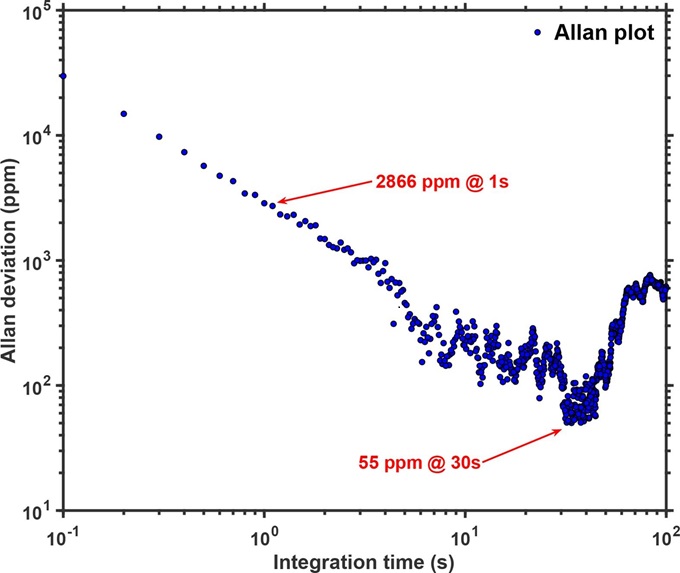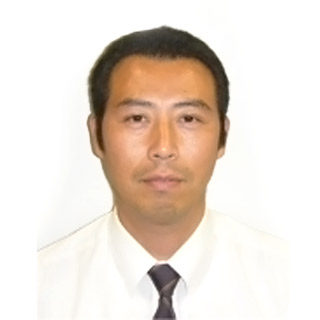Researchers developed a new method for accurately detecting hydrogen with high sensitivity using tunable diode laser absorption spectroscopy
Hydrogen, a promising fuel, has extensive applications in many sectors. However, its safe and widespread use necessitates reliable sensing methods. While tunable diode laser absorption spectroscopy (TDLAS) has proved to be an effective gas sensing method, detecting hydrogen using TDLAS is difficult due to its weak light absorption property in the infrared region. Addressing this issue, researchers developed an innovative calibration-free technique that significantly enhances the accuracy and detection limits for sensing hydrogen using TDLAS.

Image title: Hydrogen detection using tunable diode laser absorption spectroscopy (TDLAS)
Image caption: Deviation of measured concentration (in parts per million) over varying integration times resulting from Allan deviation.
Image credit: Tatsuo Shiina from Chiba University
https://www.sciencedirect.com/science/article/pii/S0030399224010454
Image license: CC BY 4.0
Usage restrictions: You are free to share and adapt the material. Attribution is required, with a link to the license, and you must indicate if changes are made to the work.
Hydrogen gas is a promising energy source with several advantages – it is lightweight, storable, energy-dense, and environmentally friendly compared to fossil fuels, producing no pollutants or greenhouse gas emissions. As such, it has extensive applications across different fields, including transportation, architecture, power generation, and industries. However, hydrogen is highly flammable, and therefore its safe and widespread use requires reliable methods for detecting leaks and ensuring its purity. The need for reliable detection methods has necessitated the development of trace-gas sensing techniques. While several methods have been developed for hydrogen sensing, none offer optimal performance.
One promising method is tunable diode laser absorption spectroscopy (TDLAS) technology, which has gained significant attention for detecting various gases. TDLAS offers several key advantages, including non-contact measurement, in situ detection, high selectivity, rapid response, low cost, and multi-component, multi-parameter measurement capabilities. It works on the principle that gases absorb light at a specific wavelength, resulting in a dark line in the absorption spectrum, known as the absorption line. By measuring the amount of laser light that has been absorbed at this wavelength, the concentration of the gas can be determined. However, detecting low concentrations of hydrogen with TDLAS is difficult because hydrogen has weaker absorption in the infrared region compared to other gases.
To address this issue, a research team from Japan led by Associate Professor Tatsuo Shiina from the Graduate School of Engineering, Chiba University, developed an innovative method for precise hydrogen gas measurement using TDLAS. The team comprised Alifu Xiafukaiti and Nofel Lagrosas from the Graduate School of Engineering, Chiba University, Ippei Asahi from the Shikoku Research Institute Inc., and Shigeru Yamaguchi from the School of Science, Tokai University. Their study was made available online on August 13, 2024, and published in Volume 180 of the journal Optics and Laser Technology on January 01, 2025.
“In this study, we achieved highly sensitive detection of hydrogen gas through meticulous control of pressure and modulation parameters in the TDLAS setup. Additionally, we introduced a calibration-free technique that ensures the adaptability to a wide range of concentrations,” explains Prof. Shiina.
In TDLAS, laser light is passed through a pressurized gas cell called a Herriott multipass cell (HMPC) containing the target gas. The laser’s wavelength is modulated or oscillated around the target absorption line of the gas at a specific frequency to remove any environmental noise. The pressure in HMPC can significantly influence the absorption line width and consequently the modulation parameters under TDLAS.
The researchers carefully analyzed the width of hydrogen’s strongest absorption line at different pressures. Through simulations, the researchers identified the optimal pressure for a broader absorption line width and the most effective modulation parameters within this line width. Their calibration-free technique involved using the first harmonic of the modulated absorption signal to normalize the second harmonic through their ratio, instead of just relying on the second harmonic signal as in conventional TDLAS systems. Additionally, they employed a high-pressure gas cell containing pure hydrogen as a reference to fine-tune the modulating parameters of the laser signal.
Through this innovative approach, the researchers achieved accurate measurements of hydrogen concentrations in a wide detection range from 0.01% to 100%, where 0.01% equals a concentration of just 100 parts per million (ppm). Moreover, the results improved with longer integration times (the time period during which light is allowed to be absorbed). At 0.1 second integration time, the minimum detection limit was 0.3% or 30,000 ppm, which improved to 0.0055% or 55 ppm at 30 seconds integration time. However, beyond 30 seconds the minimum detection limit increased.
“Our system can significantly improve hydrogen detection systems for safety and quality control, facilitating wider adoption of hydrogen fuel. For example, this system can be reliably used for the detection of leakages in hydrogen fuel cell cars,” remarks Prof. Shiina about the potential applications of the study.
To summarize, this pioneering technique could help pave the way for a sustainable future and boost the implementation of hydrogen as an eco-friendly fuel.
About Associate Professor Tatsuo Shiina
Dr. Tatsuo Shiina is currently an Associate Professor at the Graduate School of Engineering at Chiba University, Japan. He received his Ph.D. degree from Tokyo University of Science in 1998. He has published over 80 articles that have received over 300 citations and an impressive h-index of 11. His research focuses on photoelectric measurement and scattering optics. Prof. Shiina is a member of several academic societies including The Japan Society of Applied Physics, The Institute of Electronics, Information and Communication Engineers, The Institute of Electrical Engineers of Japan, The Illuminating Engineering Institute of Japan, and the Optical Society of Japan.
Funding:
This work is based on results obtained from a project, JPNP18011, commissioned by the New Energy and Industrial Technology Development Organization (NEDO).
Reference:
Title of original paper: Optimization for hydrogen gas quantitative measurement using tunable diode laser absorption spectroscopy
Authors: Alifu Xiafukaitia,b, Nofel Lagrosasa,c, Masakazu Ogitad, Nobuhiko Oid, Yuji Ichikawad, Sachiyo Sugimotod, Ippei Asahid, Shigeru Yamaguchie, Tatsuo Shiinaa
Affiliations: aGraduate School of Engineering, Chiba University, Japan
bInformation Technology R&D Center, Mitsubishi Electric Corporation, Japan
cSchool of Engineering, Kyushu University, Japan
dShikoku Research Institute Inc., Japan
eTokai University, Japan
Journal: Optics and Laser Technology
DOI: 10.1016/j.optlastec.2024.111587
Contact: Tatsuo Shiina
Graduate School of Engineering, Chiba University
Email: shiina@faculty.chiba-u.jp
Public Relations Office, Chiba University
Address: 1-33 Yayoi, Inage, Chiba 263-8522 JAPAN
Email: koho-press@chiba-u.jp
Tel: +81-43-290-2018
Recommend
-

Making the Invisible Visible: Drones Enabling Agricultural Advances
2022.10.17
-

The Global Goal of Carbon Neutrality by 2050 (Part 1): Universities as Agents of Change
2023.07.12
-

What causes nations and regions to perceive the COVID-19 crisis differently?〜Insights from the Humanities and Social Sciences Needed for Disaster Management Research
2022.12.12


